On a windswept knuckle of land that juts proudly from Mexico’s Pacific coast, a tiny town perches between cliff and sea. With a smattering of artisanal fishers and restauranteurs, Tehuamixtle has tucked into a precarious edge, protected only slightly by the jagged black headlands of Punta Ipala. To get to the town by land requires hours of bumpy dirt road travel that end at a dusty town touching a cobalt tide.
To pass here by boat, one must negotiate the exposure and potentially violent winds whipped up by the cape effect of this knobby point. Dust devils whirl from the beach up the main dirt road to the top of the town, where nervous goats bray and graze on specs of dry grass. It feels like the end of the world.
Sailboats almost never stop here: the anchorage is deep and exposed to ocean swell. Roadsteads like this translate to poor sleep as the rough swell tosses the boat on uncertain holding for the anchor, all while the heavy water surges and smashes endlessly into the steep walls. But the town is rural, remote, and forgotten in the clamor to reach the calmer waters of Puerto Vallarta nearby. I wanted to see if the pueblo’s exposure—on the edge of both land and society—make this place more vulnerable to climate change. But news rarely makes it out, so we must go ourselves. If climate change already touches people here, distance muffles the calls.
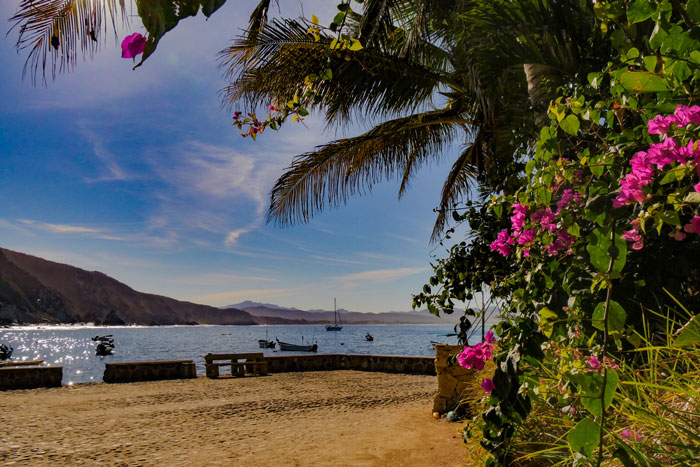
As soon as the cape winds abated, we made our break aboard Oleada, leaving mid-morning from protected Banderas Bay. We sailed south into the marine sapphire of deep water that stretches and plays with the midday rays, both revealing and obscuring a mesmerizing profundity. Dolphins frequently appeared, riding our bow wake and escorting us through brilliant sun and forgiving seas. We approached the dark headlands of Punta Ipala as the sun set, and I was disconcerted to see no sign of humans at all, only steep, dark walls. We followed our electronic chartplotter until we felt dangerously close to the rocks, and only then did the tiny town and sliver of white sands appear in a slight hook of land. Fishing pangas bobbed in the swell, and lights flickered on from the few buildings tracing the one road on the shore.
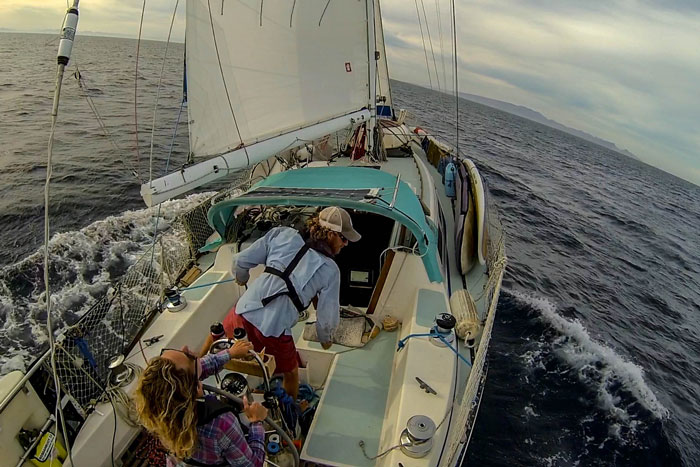
As the light faded after a long day of sailing, we ducked into the ‘anchorage’ (not so much a calm spot in this case, but shallow enough to drop the hook) in the bay of Tehuamixtle. In the dark, we launched the dinghy and I rowed blindly through a maze of anchored pangas as Josh directed me from the stern. We landed close to a cement pier at the edge of the beach that sits below the cliffs rising sharply above the town. This was fortunate, since the surf pounded the rest of the sand beach that curved into the dark. I found myself marveling at this good choice: Josh has remarkable intuition about water, including the ‘where to land the dinghy in the dark’ sense.
A brightly colored restaurant, La Galleta, glowed on the shore, and we carried the dinghy out of the surging surf up to the edge of the building only a few steps away. When I poked my head into the open air and yellow light of the dining area, I spotted rows of plastic cloth-clad tables and the ubiquitous plastic armchairs of Mexico’s coastal eating shacks, but only one woman sat talking with two men.
“Muy buenas noches. Están abierto?” The woman turned with a mix of mild annoyance and faint intrigue.
“No. Pero pásales.” Despite not being open, she invited us in, not with a smile but with a respectful nod to her visitors as she pulled her heavy frame out one of her plastic chairs. She handed us fraying menus as we sunk into our seats behind the bright floral tablecloth. These plastic armchairs feel like heaven after a long day on a sailboat—comfortable, supportive to a slumping frame, and pleasantly flexible in their cheapness. We gratefully drank two strangely small bottles of Corona as she told us the offerings: either pescado or langosta. She brought the lobsters to the table to show us the size, part of the process of dinner selection. They were wrapped in cellophane, and we chose the one that was shorter than her forearm. Ensconced in the orange, green, and blue warmth of the open air restaurant, our feet in the sand, we chewed on delicious ceviche tostadas while we waited for more food. By design, the surf was only a few feet away; Mexicans love to sit with their chairs and feet in the constant shuffle of the tide. It’s a fixture at nearly every beach town we anchored.
A few towns, like Altata and Puerto Madero, replaced these ramshackle beach haunts with lovely malecóns, boardwarks abruptly meeting the tide in white and pink textured cement. It was a new, less slouchy kind of coastal enjoyment, and the Mexicans adapted in these places by moving their restaurants across the street from the walkway. But a plastic chair sits differently on concrete than on sand: one doesn’t quite literally sink into the surroundings in the same way. A little bit of the vibe was lost, but usually local pride swelled anew around the promenade. Meanwhile, the wash of the surf scraped endlessly at the shore.
Fifteen minutes later, a lobster that had been split in half lengthwise overflowed with steaming meat on a plate before Josh; I dove into my red snapper, hot and aromatic with garlic. We ate quietly under the hanging buoys that had been painted with sea scenes, whales, and dolphins. There were even old, Japanese style buoys presiding from above, thick glass orbs adding to the gentle glow. Shell mobiles waved gently in the breeze on the porch. The color and charm overwhelmed the kitsch.
Inside the cement wall, we ate just out of reach of the surf. Does the water ever come up to the restaurant? The woman nodded yes and walked to the edge of the floor on one side of the restaurant, where a rocky cliff met the side of her concrete structure. Her restaurant truly perched between the rocks and the sea.
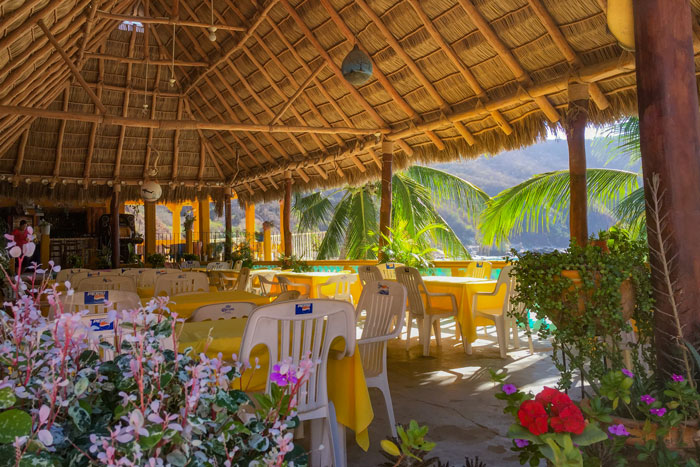
“MEECH,” she stated, gesturing over her head. I looked blankly at her, so she repeated the word three more times, before she finally added the key word: huracán. Right! Hurricane Mitch! The water and waves would have been over our heads where we sat with our seafood.
You don’t worry about more hurricanes? She only shrugged. She wasn’t giving up any more thoughts, so I pondered this precarious spot, between land and sea. We paid for our food and rowed back to the boat, using the light from town to time our escape between the swells.
Sea level rise dominates the media and academic conversation about coastal climate change. In contrast to hazards like sea surface temperature change, the impacts are observable and catastrophic: when surging tides and tropical storms collude to flood major cities, we see massive damage wreaked in a short amount of time, such as with Hurricanes Katrina and Sandy. In other areas of the world, it only takes a full moon tide to permanently alter a vulnerable, low-lying coast: South Pacific island nations such as Kiritimati and low-lying continental areas such as Bangladesh have fallen prey, but even San Francisco’s popular waterfront sees pier and building damage with ‘king tides.’ The Intergovernmental Panel on Climate Change warns that 20 percent of the world’s population, 1.3 billion people, could be forced out of their homes by sea level rise in the next century.
But, in everyday life, sea level rise is not on the radar in Pacific Mexico and Central America. The fishers and business people instead talk to me about the things that are already impacting them on a daily or yearly basis: warm water that makes for poor fishing; shifting seasons that make it difficult to grow traditional crops; erratic and violent rainfall that wash away soil and roads, clogging and destroying mangroves. But Tehuamixtle is uniquely vulnerable to sea level rise, without a good place to retreat when the water rises.
The next day, we rowed back to see the rest of the town in the daylight before we left to a safer harbor. Like almost all of Mexico’s towns, restaurants lined the beach’s small, sloping arc. But unlike other places, these spindly shacks were pinned between a cliff and the surf—there was nowhere else to go, aside from twenty feet up on the crumbling rocks.
The tiny town rose from one road, used for the sole purpose of launching boats, into the cliff, and we could see the dirt road that wound over the top and toward some distant civilization. A life-size sculpture of a white shark, with its mouth open and ready to chomp, sat poised over the concrete at the edge of the water. Beneath it, pangas waited for their fishermen, fiberglass boats looking quite vulnerable out of the water.
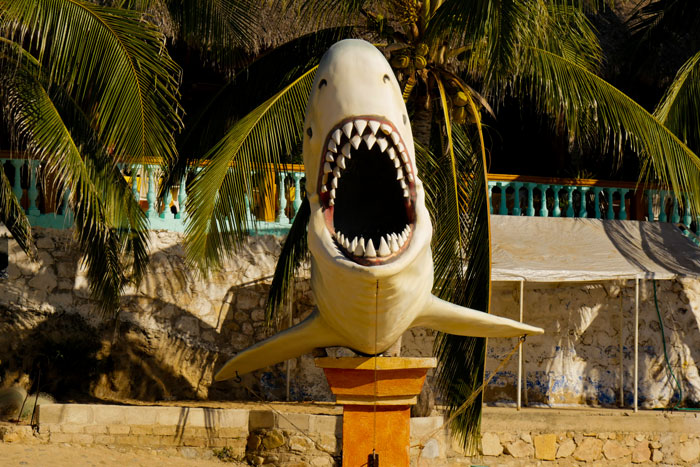
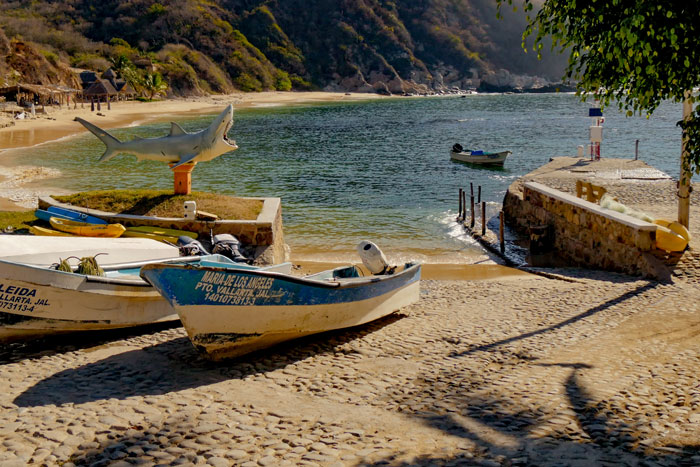
We wandered over to a restaurant perched above the water and backed up against the headland cliff and found two men unloading a truck. One of the men, Cande, was the restaurant proprietor. With chin tilted high, he talked about his speck of a town.
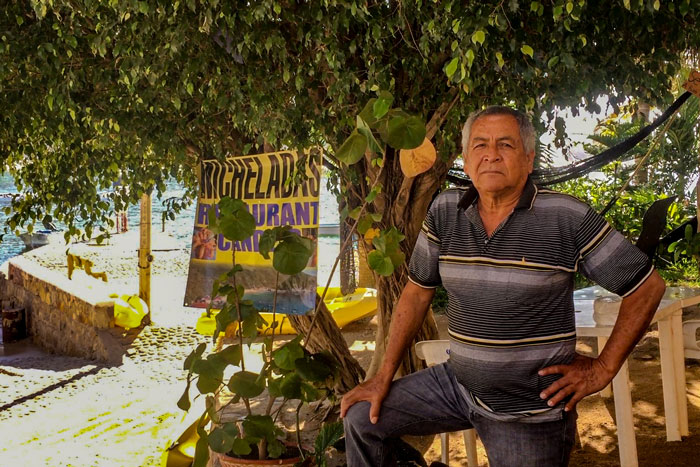
“The town has been an active port for 500 years.” He watched me to let that sink in. It didn’t seem like the most ideal place to anchor a Spanish galleon, especially with the safer water of Banderas Bay nearby. Yet jutting proudly out from the rest of the Mexican coast, it could offer a smaller boat protection in the small bay, and access to a remote peninsula’s wood and resources.
Cande told me the old adobe ruin at the end of the beach had belonged to an American who sold tobacco and coffee. A French guy succeeded him, selling solid wood. All of this was in living memory for Cande, so this was striking to me: the waves were starting to take the adobe structure. Half had already eroded into the sea. Each tide reached into the first floor of what was once, in recent memory, a functioning depot. Cande was delighted by my interest, and gestured around the town, pointing out the homes of friends and relatives.
“I care about this place and the history—because it’s mine.” He stated this not with the tone of ownership, but of a bloodline-deep pride, like his skin and the soil were shaped from the same matter, indivisible. The light-eyed man next to him unloading the truck, Lorenzo, laughed and feigned indignation.
“Hey, it’s mine too.” Both men have lived here their entire lives.
Lorenzo is from a town, Mixtla, “thirty minutes walking, five minutes by car” from Tehuamixtle. His whole life he has been a pescador and a diver, but there are menos productos, fewer fish, lobster, and octopus, nowadays. I tried to take their photo together, but each wanted his photo separate. I could hear the goats braying faintly from the top of the town hill behind me as they stood with their back to the shore.
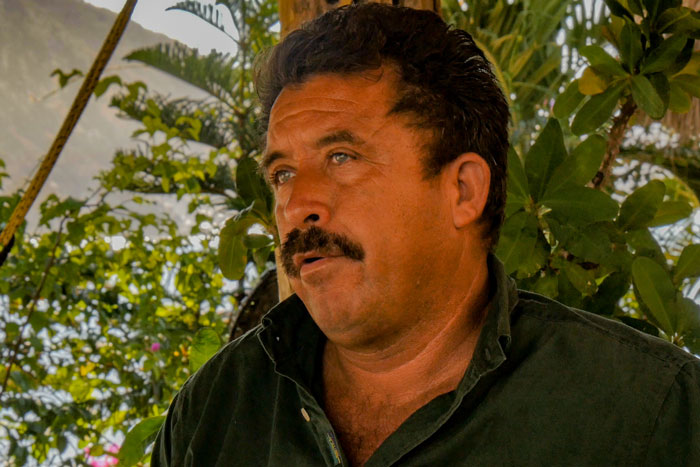
As we walked up the short road to the top of the town hill in the early morning sun, I could feel the relaxed pace of life pervading the four streets. Residents sat in woven chairs in the angular shadows of the few concrete houses, watching us with mild curiosity. A woman sweeping the dirt in front of her house paused for a moment to regard us. A shallow gutter ran down the center of the cobbled main road to drain water to the sea. The top of the hill only revealed the small goat herd and the incongruous cement arch over the dirt road, signifying entry to the town below. Even as the arch seemed inordinately grand, I realized it matched the beautifully outsized local pride.
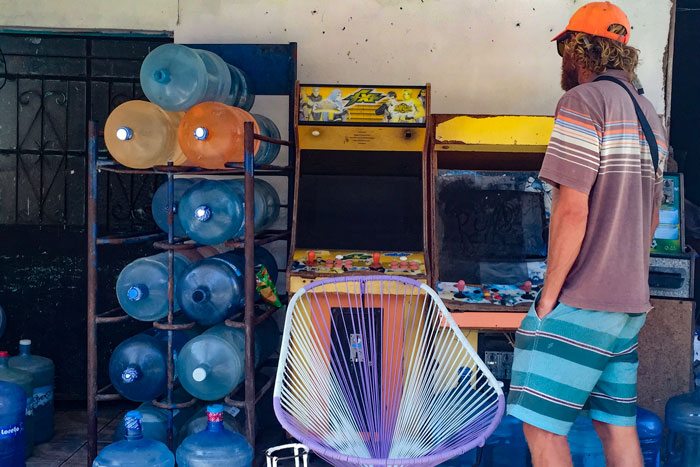
When we walked back to our dinghy, I noticed that the beach chairs and tables had sunk into the sand from the long reaches of the full moon tide.
What happens here when the tide stops receding? When I think about sea level rise, I often think of this beach and other coastlines of Mexico and Central America. Will people just move back away from the water, with concrete and rebar left rotting and tumbling into the rising surf? It certainly doesn’t seem like Cande or Lorenzo are going anywhere. But all of the other residents I saw were older. As the sea rises, the next generation of fishers and restaurant owners drain towards the cities. Many have already been pushed that way by economics, ahead of the tide. But in the poorer areas of Honduras and Nicaragua further south, mobility isn’t easy; much of it hinges on education and the ability to gain at least a high school level. The young people didn’t want to leave, most told us. They wanted to stay with their families. But the traditional ways of the sea and land were increasingly unavailable, so students left with the hopes that, someday, they could return.
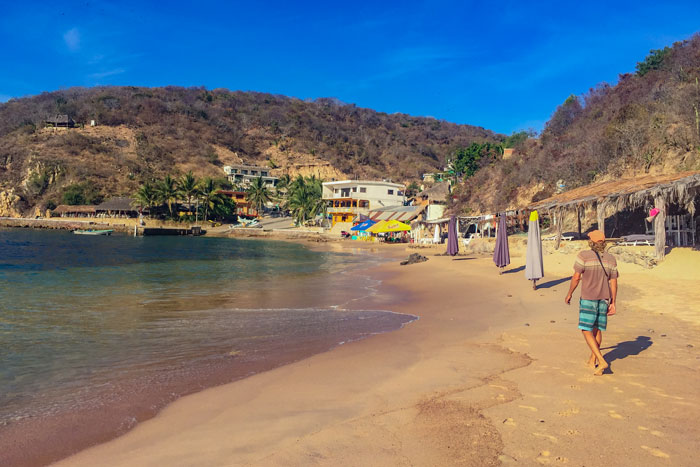
Like most of the places we visited in Mexico, sea level rise was not on the list of concerns—but it was already an occasional part of life, with seasonal storm surge and increasingly frequent hurricanes. The ability to survive and make a livable wage from the sea—and hold onto that lifestyle—stood out as the most pressing concern, as fish, lobsters, and octopus dwindled. The pride in taking a living from the sea twinkled in Lorenzo eyes, and the joy of belonging shone from Cande’s squared shoulders. Their jobs are not just about pay: they are closely linked with generational skill sets, a tight community, and deep cultural pride on the coast. These factors can fade at the same pace as climate change rises: insidious, but real, and only occasionally on the lips of locals unless actively addressed.
I didn’t want to leave, but Oleada bobbed in the building swell, reminding me that any comfort in this exposed anchorage was only temporary. We rowed our dinghy through the tight maze of mooring buoys and pangas waiting for their turn at sea.
After 500 years, this town of 200 residents, sandwiched between a cliff and the sea, has managed to survive. It remains to be seen how resilient they will be with fewer fish, a rising tide, and back up against a cliff. But pride and legacy are powerful motivators, and the sea continues its siren sound.
